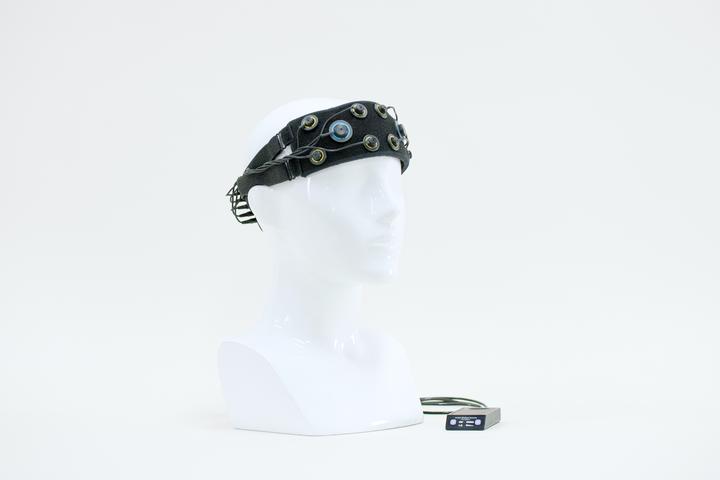
Publications using the OctaMon
Feasibility of combining functional near-infrared spectroscopy with electroencephalography to identify chronic stroke responders to cerebellar transcranial direct current stimulation—a computational modeling and portable neuroimaging methodological study
Feasibility of portable neuroimaging of cerebellar transcranial direct current stimulation (ctDCS) effects on the cerebral cortex has not been investigated vis-à-vis cerebellar lobular electric field strength. We studied functional near-infrared …
fNIRS signal quality estimation by means of a machine learning algorithm trained on morphological and temporal features
Functional near infrared spectroscopy (fNIRS) is used for brain hemodynamic assessment. Cortical hemodynamics are reliably estimated when the recorded signal has a sufficient quality. This is acquired when fNIRS optodes have proper scalp coupling. A …
Hemodynamic and behavioral changes in older adults during cognitively demanding dual tasks
Introduction: Executive functions play a fundamental role in walking by integrating information from cognitive-motor pathways. Subtle changes in brain and behavior may help identify older adults who are more susceptible to executive function deficits …
Measuring Mental Workload Variations in Office Work Tasks using fNIRS
The motivation behind using physiological measures to estimate cognitive activity is typically to build technology that can help people to understand themselves and their work, or indeed for systems to do so and adapt. While functional Near Infrared …
Physiological indicators of task demand, fatigue, and cognition in future digital manufacturing environments
As Digital Manufacturing transforms traditionally physical work into more system-monitoring tasks, new methods are required for understanding people's mental workload and prolonged capacity for focused attention. Many physiological measures have …
Prefrontal cortex involvement during dual-task stair climbing in healthy older adults: An fNIRS study
Executive function and motor control deficits adversely affect gait performance with age, but the neural correlates underlying this interaction during stair climbing remains unclear. Twenty older adults (72.7 ± 6.9 years) completed single tasks: …
Physiological correlates of cognitive load in laparoscopic surgery
Laparoscopic surgery can be exhausting and frustrating, and the cognitive load experienced by surgeons may have a major impact on patient safety as well as healthcare economics. As cognitive load decreases with increasing proficiency, its robust …
Exercise-based cardiac rehabilitation improves cognitive function among patients with cardiovascular disease
Purpose: To investigate the effects of cardiac rehabilitation (CR) exercise training on cognitive performance and whether the changes are associated with alterations in prefrontal cortex (PFC) oxygenation among patients with cardiovascular disease. …
Signal quality index: an algorithm for quantitative assessment of functional near infrared spectroscopy signal quality
We propose the signal quality index (SQI) algorithm as a novel tool for quantitatively assessing the functional near infrared spectroscopy (fNIRS) signal quality in a numeric scale from 1 (very low quality) to 5 (very high quality). The algorithm …
Effect of Different Intensities of Transcranial Direct Current Stimulation on Postural Response to External Perturbation in Patients With Parkinson's Disease
Background: Habituation of postural response to perturbations is impaired in people with Parkinson's disease (PD) due to deficits in cortico-basal pathways. Although transcranial direct current stimulation (tDCS) modulate cortico-basal networks, it …
Levodopa Facilitates Prefrontal Cortex Activation During Dual Task Walking in Parkinson Disease
Background. Although dopaminergic medication improves dual task walking in people with Parkinson disease (PD), the underlying neural mechanisms are not yet fully understood. As prefrontal cognitive resources are involved in dual task walking, …
Changes in Cortical Activation during Dual-Task Walking in Individuals with and without Visual Vertigo
Background and Purpose: Persons with vestibular disorders are known to have slower gait speed with greater imbalance and veering during dual-task walking than healthy individuals, but the cerebral mechanisms are unknown. The purpose of this study was …
Unveilling the cerebral and sensory contributions to automatic postural control during dual-task standing
Objectives: The postural control dual-task literature has demonstrated greater postural stability during dual-task in comparison to single task (i.e., standing balance alone through the examination of multiple kinetic and kinematic measures. This …
A functional near-infrared spectroscopy (fNIRS) examination of how self-initiated sequential movements become automatic
The neural mechanisms underlying movement automaticity have been investigated using PET and fMRI and more recently functional near-infrared spectroscopy (fNIRS). As fNIRS is an emerging technique, the objective of the present study was to replicate …
Simultaneous functional near infrared spectroscopy of the brain and bladder
Background: Worldwide 2.3 billion individuals are affected by bladder disease. The current evaluative test is invasive, associated with complications and often declined. Non-invasive evaluation of bladder hemodynamics using continuouswave …
Combining Frontal Transcranial Direct Current Stimulation With Walking Rehabilitation to Enhance Mobility and Executive Function: A Pilot Clinical Trial
Objectives: This pilot study assessed whether frontal lobe transcranial direct current stimulation (tDCS) combined with complex walking rehabilitation is feasible, safe, and shows preliminary efficacy for improving walking and executive function. …
DESIGN AND EVALUATION OF A GUI FOR SIGNAL AND DATA ANALYSIS OF MOBILE FUNCTIONAL NEAR-INFRARED SPECTROSCOPY SYSTEMS A Thesis by
Functional near-infrared spectroscopy (fNIRS) is an emerging neuro-imaging modality that can indicate cortical functionality with good temporal resolution (0.5-1 sec). Unlike fMRI, up to now, there is no standard method and a whole package that can …
Executive Control of Walking in People With Parkinson's Disease With Freezing of Gait
Background: Walking abnormalities in people with Parkinson's disease (PD) are characterized by a shift in locomotor control from healthy automaticity to compensatory prefrontal executive control. Indirect measures of automaticity of walking (eg, …
Exercise-Based cardiac rehabilitation modulates prefrontal cortex oxygenation during submaximal exercise testing in cardiovascular disease patients
The purpose of this study was to investigate if prefrontal cortex (PFC) oxygenation during incremental exercise is altered among cardiovascular disease (CVD) patients who completed 6 weeks of exercise-based cardiac rehabilitation (CR). Nineteen (male …
Is Cortical Activation During Walking Different Between Parkinson's Disease Motor Subtypes?
Parkinson's disease (PD) is often classified into tremor dominant (TD) and postural instability gait disorder (PIGD) subtypes. Degeneration of subcortical/cortical pathways is different between PD subtypes, which leads to differences in motor …